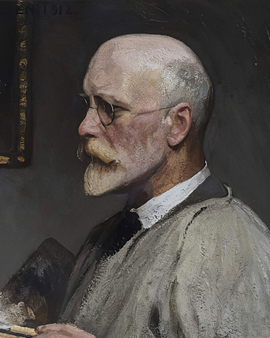


Many of the works of the British painter Sir George Clausen have one motif in common - the English landscape and the rural population that goes about their work. Clausen shows the hard work of the farmers, observes them sowing, mowing and harvesting or shows how the blacksmith goes about his sweaty work. He deals with the simple life of simple people and manages to create idyllic scenes. The landscapes Clausen shows in his paintings seem peaceful and are, one cannot say otherwise, simply beautiful. He often shows a wide sky, the clouds are moving, the grass is moving in the wind. His portraits of young women and girls are also enchanting, with an alert eye directly encountering that of the viewer.
George Clausen first learned his trade in London and was already a successful painter during his studies, working in the studio of the popular artist Edwin Long. Clausen also travelled to Holland and Belgium, where he studied the local artists and their works. Later he was drawn to Paris. There he was a student at the Académie Julian art school and a period began which would have a decisive influence on George Clausen and his work. Here, for example, he strongly oriented himself on the works of the painter Jules Bastien Lepage, who died young and who also chose the rural life of the farmers as his motif. George Clausen was also influenced by the rise of Impressionism. Inspired by the paintings Édouard Manets, Claude Monets or Alfred Sisleys, their influences are clearly evident in Clausen's work. He also played with light and shadow and experimented with wilder, freer brushstrokes. Clausen's work thus combines naturalism with romanticism and impressionism.
Clausen's motives changed with the outbreak of the First World War. Although the painter was not drafted, he was appointed an official martial artist. As one of the most important British artists of his time - he now even taught painting at the Royal Academy - he was to help the British government to carry out war propaganda and demonstrate the size and power of the kingdom. In gloomy black and white lithographs, for example, he shows the production of weapons of war. The contrast to his once light-flooded landscapes is extreme. And the darkness of war is also clearly visible in his paintings from this period. His landscapes are now greyer and duller, sadness has overtaken them.
1927 George Clausen is honoured for his life's work and merits and is knighted. Today his impressive works adorn museums and galleries worldwide.

Many of the works of the British painter Sir George Clausen have one motif in common - the English landscape and the rural population that goes about their work. Clausen shows the hard work of the farmers, observes them sowing, mowing and harvesting or shows how the blacksmith goes about his sweaty work. He deals with the simple life of simple people and manages to create idyllic scenes. The landscapes Clausen shows in his paintings seem peaceful and are, one cannot say otherwise, simply beautiful. He often shows a wide sky, the clouds are moving, the grass is moving in the wind. His portraits of young women and girls are also enchanting, with an alert eye directly encountering that of the viewer.
George Clausen first learned his trade in London and was already a successful painter during his studies, working in the studio of the popular artist Edwin Long. Clausen also travelled to Holland and Belgium, where he studied the local artists and their works. Later he was drawn to Paris. There he was a student at the Académie Julian art school and a period began which would have a decisive influence on George Clausen and his work. Here, for example, he strongly oriented himself on the works of the painter Jules Bastien Lepage, who died young and who also chose the rural life of the farmers as his motif. George Clausen was also influenced by the rise of Impressionism. Inspired by the paintings Édouard Manets, Claude Monets or Alfred Sisleys, their influences are clearly evident in Clausen's work. He also played with light and shadow and experimented with wilder, freer brushstrokes. Clausen's work thus combines naturalism with romanticism and impressionism.
Clausen's motives changed with the outbreak of the First World War. Although the painter was not drafted, he was appointed an official martial artist. As one of the most important British artists of his time - he now even taught painting at the Royal Academy - he was to help the British government to carry out war propaganda and demonstrate the size and power of the kingdom. In gloomy black and white lithographs, for example, he shows the production of weapons of war. The contrast to his once light-flooded landscapes is extreme. And the darkness of war is also clearly visible in his paintings from this period. His landscapes are now greyer and duller, sadness has overtaken them.
1927 George Clausen is honoured for his life's work and merits and is knighted. Today his impressive works adorn museums and galleries worldwide.
Page 1 / 2






